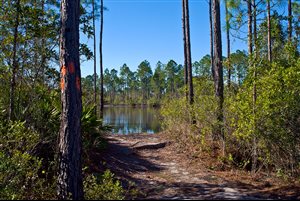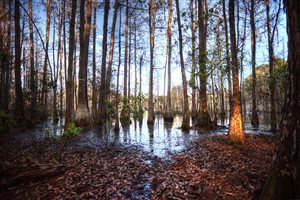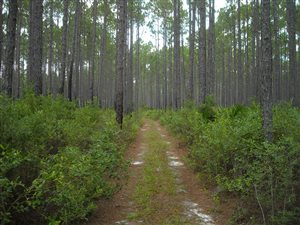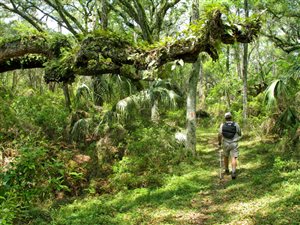Facts and Statistics

Over the course of its length, it displays incredible history, biodiversity and a rich culture of flora and fauna. It starts at the Big Cypress National Reserve and ends at Fort Pickens, in the Gulf Islands National Seashore. It can be accessed within an hour by most residents of Florida.
Its first blaze was marked by the membership of Florida Trail Association, in the Ocala National Forest, at Clearwater Lake Recreation Area. It began on 29 October 1966. In 1983, it was officially elevated to the status of a National Scenic Trail. Its official administrator is the National Forests in Florida program. However, trail development, care, and maintenance are mainly carried out by a group of volunteers and members of Florida Trail Association and other groups.
The Route

In the northern region, the trail passes through Rice Creek Conservation Area, Etoniah Creek State Forest, Fall Creek, Plum Creek, Osceola National Forest, Swift Creek Conservation Area, and Camp Branch Conservation Area. Thereafter, the trail traverses Suwannee River Management Areas, Lower Alpha Conservation Area, Holton Creek Conservation Area, Suwannee River State Park, Twin Rivers State Forest, and Aucilla River.
In the Southern Region, the Florida Hiking Trail Passes through the Big Cypress National Preserve Miami Canal Levee, Kissimmee River, Lake Okeechobee, And Avon Park Air Force Range. It then finishes off at KICCO Wildlife Management Area.

In the Panhandle Region, this hiking trail passes through the following forests and reserves. They are St. Marks National Wildlife Refuge, Tallahassee-St. Marks Historic Railroad State Trail, Apalachicola National Forest, Blountstown Greenway & SR20, Upper Chipola Water Management Area, and Econfina Creek Water Management Area. It then takes you through Pine Log State Forest, Choctawhatchee River Water Management Area, Yellow River Water Management Area and finally at the Gulf Islands National Seashore.
Flora and Fauna
Florida is home to a wide range of environments that are unique to the area itself. This implies that there are nature viewing opportunities and amazing wildlife on the Florida Nature Trail. This hiking trail crosses both remote and urban wilderness areas, while traversing different semi-tropical ecosystems. Good hiking boots are advised for this trip. From forests to prairies to swamps, there are endless opportunities for exploration. You can even beach walk on the Florida National Scenic Trail.
Flora

In the central region, the trail passes through pine flatwoods, palmetto prairies, ranch land, freshwater marshes, cypress sloughs, oak hammocks, and scrub. The wide range of vegetation gives this area beautiful scenery.
Wine grass and long leaf are common forms of vegetation found in the Northern Region. Hikers can also come across flatwoods, hardwoods, pine plantations, oak hammocks, and cypress, among others.
The Panhandle Region is the final section of the trail, depending on which side you start your thru-hike. Vegetation found in this area include salt marsh, coastal pine flatwoods, oak hammocks, wild ground orchids, dune grasses, titi swamps, and pitcher plants, just to name a few.
Fauna

Common wildlife in the Northern Region includes woodpeckers, red-cockaded, eastern cottontail rabbits, Gulf sturgeon, gopher tortoises, and deers among others. In the Panhandle Region of the Florida Trail, you are likely to encounter bald eagles, waterfowl, otters, alligators, black bears, deers, sea turtles, piping plovers, and warblers.
Things to Observe
There are several species of venomous snakes found along this trail. Therefore, it is important to take caution whenever you are hiking. Some of the snakes you are likely to encounter include coral snakes, southern copperhead, Florida cottonmouth, diamond rattlesnakes among others.
Management

A coalition was formed in 2010 by the National Forests in Florida supervisor with the aim of bringing on board a bigger group partners in the management of the trail. This was meant to ensure that this large natural resource is properly taken care of and the right programs put in place. The coalition is comprised of a large group of stakeholders who should ensure that high quality standards are maintained in the management of Florida National Scenic Trail.
The trail has modern facilities, is well maintained, and can accommodate a wide range of users. It includes children and people with accessibility needs. All people are encouraged to get outdoors and have fun, while still enjoying the beauty of the natural environment.
Bottom Line
Florida Trail is one of the most bio-diverse regions in the United States. It providers hikers and others alike with a unique opportunity to day hike or hike through. It presents a unique opportunity of seeing beautiful environments and ecosystems.
How To Hike The Florida Trail: Weather
Navigation
[jbio template=”bootbomb0″]

Hi. Steve, 53, Maine. I have amassed all the gear I think I may require for a distance hike. It is all new, as I have not had the chance to go out. It is Dec 2019, cold in Maine, and I may fly South to FLA, Jan 2020, and try a section of the FT. Maybe Ocala to Seminole ? Any advice will be appreciated. Also, I have been reading about shoe choice. Advise on trail shoe, please…one that will stand the wet. I may decide to fly to Miami and just do the entire Thru Hike.
Hi Steven,
You sound like an ambitious guy!
I think any hiking shoe from these reviews would do nicely.
Just make sure to choose one that’s waterproof, like you want it to be.
Let me know how that trip was!
Sincerely,
Brian